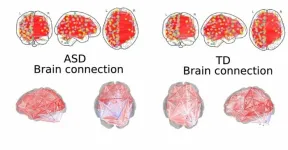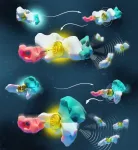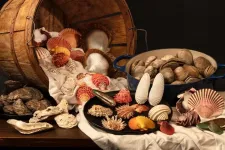(Press-News.org) As the chords of Pink Floyd's “Another Brick in the Wall, Part 1,” filled the surgery suite, neuroscientists at Albany Medical Center diligently recorded the activity of electrodes placed on the brains of patients undergoing epilepsy surgery.
The goal? To capture the electrical activity of brain regions tuned to attributes of the music — tone, rhythm, harmony and words — to see if they could reconstruct what the patient was hearing.
More than a decade later, after detailed analysis of data from 29 such patients by neuroscientists at the University of California, Berkeley, the answer is clearly yes.
The phrase "All in all it was just a brick in the wall" comes through recognizably in the reconstructed song, its rhythms intact, and the words muddy, but decipherable. This is the first time researchers have reconstructed a recognizable song from brain recordings.
The reconstruction shows the feasibility of recording and translating brain waves to capture the musical elements of speech, as well as the syllables. In humans, these musical elements, called prosody — rhythm, stress, accent and intonation — carry meaning that the words alone do not convey.
Because these intracranial electroencephalography (iEEG) recordings can be made only from the surface of the brain — as close as you can get to the auditory centers — no one will be eavesdropping on the songs in your head anytime soon.
But for people who have trouble communicating, whether because of stroke or paralysis, such recordings from electrodes on the brain surface could help reproduce the musicality of speech that's missing from today's robot-like reconstructions.
"It's a wonderful result," said Robert Knight, a neurologist and UC Berkeley professor of psychology in the Helen Wills Neuroscience Institute who conducted the study with postdoctoral fellow Ludovic Bellier. "One of the things for me about music is it has prosody and emotional content. As this whole field of brain machine interfaces progresses, this gives you a way to add musicality to future brain implants for people who need it, someone who's got ALS or some other disabling neurological or developmental disorder compromising speech output. It gives you an ability to decode not only the linguistic content, but some of the prosodic content of speech, some of the affect. I think that's what we've really begun to crack the code on."
As brain recording techniques improve, it may be possible someday to make such recordings without opening the brain, perhaps using sensitive electrodes attached to the scalp. Currently, scalp EEG can measure brain activity to detect an individual letter from a stream of letters, but the approach takes at least 20 seconds to identify a single letter, making communication effortful and difficult, Knight said.
"Noninvasive techniques are just not accurate enough today. Let's hope, for patients, that in the future we could, from just electrodes placed outside on the skull, read activity from deeper regions of the brain with a good signal quality. But we are far from there," Bellier said.
Bellier, Knight and their colleagues reported the results today in the journal PLOS Biology, noting that they have added "another brick in the wall of our understanding of music processing in the human brain."
Reading your mind? Not yet.
The brain machine interfaces used today to help people communicate when they're unable to speak can decode words, but the sentences produced have a robotic quality akin to how the late Stephen Hawking sounded when he used a speech-generating device.
"Right now, the technology is more like a keyboard for the mind," Bellier said. "You can't read your thoughts from a keyboard. You need to push the buttons. And it makes kind of a robotic voice; for sure there's less of what I call expressive freedom."
Bellier should know. He has played music since childhood — drums, classical guitar, piano and bass, at one point performing in a heavy metal band. When Knight asked him to work on the musicality of speech, Bellier said, "You bet I was excited when I got the proposal."
In 2012, Knight, postdoctoral fellow Brian Pasley and their colleagues were the first to reconstruct the words a person was hearing from recordings of brain activity alone.
More recently, other researchers have taken Knight's work much further. Eddie Chang, a UC San Francisco neurosurgeon and senior co-author of the 2012 paper, has recorded signals from the motor area of the brain associated with jaw, lip and tongue movements to reconstruct the speech intended by a paralyzed patient, with the words displayed on a computer screen.
That work, reported in 2021, employed artificial intelligence to interpret the brain recordings from a patient trying to vocalize a sentence based on a set of 50 words.
While Chang's technique is proving successful, the new study suggests that recording from the auditory regions of the brain, where all aspects of sound are processed, can capture other aspects of speech that are important in human communication.
"Decoding from the auditory cortices, which are closer to the acoustics of the sounds, as opposed to the motor cortex, which is closer to the movements that are done to generate the acoustics of speech, is super promising," Bellier added. "It will give a little color to what's decoded."
For the new study, Bellier reanalyzed brain recordings obtained in 2012 and 2013 as patients were played an approximately 3-minute segment of the Pink Floyd song, which is from the 1979 album The Wall. He hoped to go beyond previous studies, which had tested whether decoding models could identify different musical pieces and genres, to actually reconstruct music phrases through regression-based decoding models.
Bellier emphasized that the study, which used artificial intelligence to decode brain activity and then encode a reproduction, did not merely create a black box to synthesize speech. He and his colleagues were also able to pinpoint new areas of the brain involved in detecting rhythm, such as a thrumming guitar, and discovered that some portions of the auditory cortex — in the superior temporal gyrus, located just behind and above the ear — respond at the onset of a voice or a synthesizer, while other areas respond to sustained vocals.
The researchers also confirmed that the right side of the brain is more attuned to music than the left side.
"Language is more left brain. Music is more distributed, with a bias toward right," Knight said.
"It wasn't clear it would be the same with musical stimuli," Bellier said. "So here we confirm that that's not just a speech-specific thing, but that's it’s more fundamental to the auditory system and the way it processes both speech and music."
Knight is embarking on new research to understand the brain circuits that allow some people with aphasia due to stroke or brain damage to communicate by singing when they cannot otherwise find the words to express themselves.
Other co-authors of the paper are Helen Wills Neuroscience Institute postdoctoral fellows Anaïs Llorens and Déborah Marciano, Aysegul Gunduz of the University of Florida and Gerwin Schalk and Peter Brunner of Albany Medical College in New York and Washington University, who captured the brain recordings.
END
Brain recordings capture musicality of speech — with help from Pink Floyd
Neuroscientists decode song from brain recordings, revealing areas dealing with rhythm and vocals
2023-08-15
ELSE PRESS RELEASES FROM THIS DATE:
Study proposes use of artificial intelligence to diagnose autism spectrum disorder
2023-08-15
Diagnosing autism spectrum disorder (ASD) is still a daunting challenge because of the degree of complexity involved, requiring highly specialized professionals. Autism is a multifactorial neurodevelopment disorder with widely varying symptoms. In the United States, about 1 in 36 children have been diagnosed with ASD, according to the Centers for Disease Control and Prevention (CDC), and yet there are no biochemical markers to identify it with precision. A quantitative diagnostic method is proposed by Brazilian researchers in an article published in ...
New algorithm captures complex 3D light scattering information from live specimens
2023-08-15
BOSTON - Researchers have developed a new algorithm for recovering the 3D refractive index distribution of biological samples that exhibit multiple types of light scattering. The algorithm helps optimize a new imaging approach called intensity diffraction tomography (IDT).
Jiabei Zhu from Boston University will present this research at the Optica Imaging Congress. The hybrid meeting will take place 14 – 17 August 2023 in Boston, Massachusetts.
“3D quantitative phase imaging (QPI) has superior features for various applications in the field of biomedical imaging. As a label-free technique, QPI ...
Advanced magnesium-based hydrogen storage materials and their applications
2023-08-15
As an energy carrier, hydrogen holds the prominent advantages of high gravimetric energy density, high abundance, and zero emission, yet its effective storage and transportation remain a bottleneck problem for the widespread applications of hydrogen energy. To address such an issue, different types of hydrogen storage materials are developed and carefully investigated in the past decades. Among them, magnesium hydride (MgH2) has been considered as one of the most promising hydrogen storage materials because of its high capacity, excellent reversibility, sufficient magnesium reserves, and low cost. However, the poor thermodynamic and kinetic properties ...
Decoding how molecules "talk" to each other to develop new nanotechnologies
2023-08-15
Two molecular languages at the origin of life have been successfully recreated and mathematically validated, thanks to pioneering work by Canadian scientists at Université de Montréal.
Published this week in the Journal of American Chemical Society, the breakthrough opens new doors for the development of nanotechnologies with applications ranging from biosensing, drug delivery and molecular imaging.
Living organisms are made up of billions of nanomachines and nanostructures that communicate to create higher-order entities able to do many essential things, such as moving, thinking, surviving and reproducing.
“The key to life’s emergence ...
Favored asylum seekers are young, female and fleeing war
2023-08-15
Russia’s attack on Ukraine has resulted in one of the largest movements of refugees since the Second World War. More than 7.4 million Ukrainians have sought asylum in Europe, almost three times the number of people who found refuge in Europe during Syria’s civil war in 2015 and 2016.
To investigate whether and how the willingness of host populations to receive refugees has changed since 2016, an international research team involving ETH Zurich, the University of California, Berkeley, and Stanford University surveyed 33,000 people in 15 European countries. The first wave of the survey took place in February 2016 and the second from May to June ...
More than 800 human-harvested shellfish species tend to be more resistant to extinction
2023-08-15
In a new study, scientists Stewart Edie of the Smithsonian, Shan Huang of the University of Birmingham and colleagues drastically expanded the list of bivalve species, such as clams, oysters, mussels, scallops and their relatives, that humans are known to harvest and identified the traits that make these species prime targets for harvesting. They also discovered that some of these same traits have also made this group of shellfish less prone to extinction in the past and may protect these shellfish in the future. The authors flagged certain ocean regions, such as the east Atlantic and northeast and southeast Pacific, as areas of special concern for management and conservation.
The ...
Nearly 50% of environmentalists abandoned Twitter following Musk’s takeover
2023-08-15
In October 2022, Elon Musk purchased Twitter (recently renamed X), which had previously served as the leading social media platform for environmental discourse. Since then, reports a team of researchers in the journal Trends in Ecology and Evolution on August 15, there has been a mass exodus of environmental users on the platform—a phenomenon that could have serious implications for public communication surrounding topics like biodiversity, climate change, and natural disaster recovery.
“Twitter has been the dominant social ...
Reduced grey matter in frontal lobes linked to teenage smoking and nicotine addiction – study
2023-08-15
Levels of grey matter in two parts of the brain may be linked to a desire to start smoking during adolescence and the strengthening of nicotine addiction, a new study has shown.
A team of scientists, led by the universities of Cambridge and Warwick in the UK and Fudan University in China, analysed brain imaging and behavioural data of over 800 young people at the ages of 14, 19 and 23.
They found that, on average, teenagers who started smoking by 14 years of age had markedly less grey matter in a section of the left frontal lobe linked to ...
Infants admitted to ICUs for RSV infection during the 2022 seasonal peak
2023-08-15
About The Study: In this study, most U.S. infants who required intensive care for respiratory syncytial virus (RSV) lower respiratory tract infections were young, healthy, and born at term. These findings highlight the need for RSV preventive interventions targeting all infants to reduce the burden of severe RSV illness.
Authors: Natasha Halasa, M.D., M.P.H., of the Vanderbilt University Medical Center in Nashville, and Angela P. Campbell, M.D., M.P.H., of the Centers for Disease Control and Prevention in Atlanta, are the corresponding authors.
To access the embargoed study: Visit our For The Media website at this ...
Communication of COVID-19 misinformation on social media by physicians in the US
2023-08-15
About The Study: In this study of high-use social media platforms, physicians from across the U.S. and representing a range of medical specialties were found to propagate COVID-19 misinformation about vaccines, treatments, and masks on large social media and other online platforms and that many had a wide reach based on number of followers.
Authors: Sarah L. Goff, M.D., Ph.D., of the University of Massachusetts, Amherst, is the corresponding author.
To access the embargoed study: Visit our For ...
LAST 30 PRESS RELEASES:
Why nail-biting, procrastination and other self-sabotaging behaviors are rooted in survival instincts
Regional variations in mechanical properties of porcine leptomeninges
Artificial empathy in therapy and healthcare: advancements in interpersonal interaction technologies
Why some brains switch gears more efficiently than others
UVA’s Jundong Li wins ICDM’S 2025 Tao Li Award for data mining, machine learning
UVA’s low-power, high-performance computer power player Mircea Stan earns National Academy of Inventors fellowship
Not playing by the rules: USU researcher explores filamentous algae dynamics in rivers
Do our body clocks influence our risk of dementia?
Anthropologists offer new evidence of bipedalism in long-debated fossil discovery
Safer receipt paper from wood
Dosage-sensitive genes suggest no whole-genome duplications in ancestral angiosperm
First ancient human herpesvirus genomes document their deep history with humans
Why Some Bacteria Survive Antibiotics and How to Stop Them - New study reveals that bacteria can survive antibiotic treatment through two fundamentally different “shutdown modes”
UCLA study links scar healing to dangerous placenta condition
CHANGE-seq-BE finds off-target changes in the genome from base editors
The Journal of Nuclear Medicine Ahead-of-Print Tip Sheet: January 2, 2026
Delayed or absent first dose of measles, mumps, and rubella vaccination
Trends in US preterm birth rates by household income and race and ethnicity
Study identifies potential biomarker linked to progression and brain inflammation in multiple sclerosis
Many mothers in Norway do not show up for postnatal check-ups
Researchers want to find out why quick clay is so unstable
Superradiant spins show teamwork at the quantum scale
Cleveland Clinic Research links tumor bacteria to immunotherapy resistance in head and neck cancer
First Editorial of 2026: Resisting AI slop
Joint ground- and space-based observations reveal Saturn-mass rogue planet
Inheritable genetic variant offers protection against blood cancer risk and progression
Pigs settled Pacific islands alongside early human voyagers
A Coral reef’s daily pulse reshapes microbes in surrounding waters
EAST Tokamak experiments exceed plasma density limit, offering new approach to fusion ignition
Groundbreaking discovery reveals Africa’s oldest cremation pyre and complex ritual practices
[Press-News.org] Brain recordings capture musicality of speech — with help from Pink FloydNeuroscientists decode song from brain recordings, revealing areas dealing with rhythm and vocals







